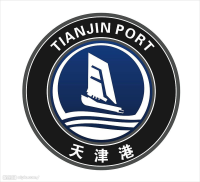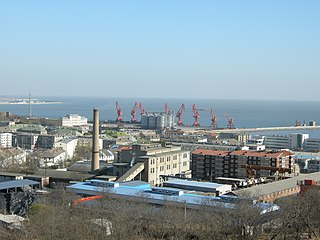
Zhenjiang, alternately romanized as Chinkiang, is a prefecture-level city in Jiangsu Province, China. It lies on the southern bank of the Yangtze River near its intersection with the Grand Canal. It is opposite Yangzhou and between Nanjing and Changzhou. Zhenjiang was formerly the provincial capital of Jiangsu and remains as an important transportation hub. As of the 2020 census, its total population was 3,210,418 inhabitants whom 1,266,790 lived in the built-up area made of the 3 urban districts. The town is best known both in China and abroad for Chinkiang vinegar, a fragrant black vinegar that is a staple of Chinese cooking.

The Port of Ningbo-Zhoushan is the busiest port in the world in terms of cargo tonnage. It handled 888.96 million tons of cargo in 2015. The port is located in Ningbo and Zhoushan, on the coast of the East China Sea, in Zhejiang province on the southeast end of Hangzhou Bay, across which it faces the municipality of Shanghai.

The Port of Xiamen is an important deep water port located on Xiamen Island, the adjacent mainland coast, and along the estuary of the Jiulong River in southern Fujian, China. It is one of the trunk line ports in the Asia-Pacific region. It is ranked the 8th-largest container port in China and ranks 17th in the world. It is the 4th port in China with the capacity to handle 6th-generation large container vessels. In 2013, Xiamen handled 191 million tons of cargo, including 8.08 million TEUs of containers. On 31 August 2010, Xiamen Port incorporated the neighboring port of Zhangzhou to form the largest port of China's Southeast. This was a relatively uncommon case of ports merging across jurisdictions.

The Port of Tianjin, formerly known as the Port of Tanggu, is the largest port in Northern China and the main maritime gateway to Beijing. The name "Tianjin Xingang", which strictly speaking refers only to the main seaport area, is sometimes used to refer to the whole port. The port is on the western shore of the Bohai Bay, centred on the estuary of the Haihe River, 170 km southeast of Beijing and 60 km east of Tianjin city. It is the largest man-made port in mainland China, and one of the largest in the world. It covers 121 square kilometers of land surface, with over 31.9 km of quay shoreline and 151 production berths at the end of 2010.

Jingkou District is one of three built-up zones (district) of Zhenjiang, Jiangsu province, China. The district has an area of 115 km2 and a population of 410,000 people. The postal code for Jingkou is 212001 and the telephone code is 0511.

The Port of Nanjing is located in Nanjing, Jiangsu Province, China, and is the largest inland port in the world, with throughput reaching 191 million tons of cargo in 2012. Nanjing Port has a long history reaching back to A.D 229, when it became a major seaport. It is situated in the lower reaches of the Yangtze River, just before the start of the Yangtze Delta. The Port has authority over 208 km of Yangtze River shoreline, 110 km in the North Shore and 98 km in the South Shore. As of 2010, it operated six public ports and three industrial ports.

The Port of Tianjin is divided into nine areas: the three core areas of Beijiang, Nanjiang, and Dongjiang around the Xingang fairway; the Haihe area along the river; the Beitang port area around the Beitangkou estuary; the Dagukou port area in the estuary of the Haihe River; and three areas under construction.
The Port of Tianjin, formerly known as the Port of Tanggu, is the largest port in Northern China and the main maritime gateway to Beijing. The name "Tianjin Xingang"(Chinese: 天津新港; pinyin: tiānjīn xīngǎng; lit. 'Tianjin New Port'), which strictly speaking refers only to the main seaport area, is sometimes used to refer to the whole port. The Port is located on the western shore of the Bohai Bay, centered on the estuary of the Haihe River, 170 km south east of Beijing and 60 km east of Tianjin city. It is the largest man-made port in mainland China, and one of the largest in the world. It covers 121 square kilometers of land surface, with over 31.9 km of quay shoreline and 151 production berths at the end of 2010.

The Port of Huludao is an artificial deep-water international seaport on the coast of Huludao, Liaoning, People's Republic of China, on the Liaodong Bay. It is one of several smaller ports being rapidly expanded in Liaoning Province in order to service the Northeast.
The Port of Shantou is a natural river seaport on the coast of the city of Shantou, Guangdong Province, People's Republic of China. It is the only major port in eastern Guangdong, and the gateway to the Shantou SEZ. In 2012, it had a throughput of 45.6 million tons of cargo, and 1,250,000 TEU of containers. Like most Chinese seaports, it has experienced frantic growth in the last two decades and has plans for large expansion in the future.
The Port of Huanghua, also known as the Port of Cangzhou Huanghua is an artificial deep-water international seaport on the coast of Huanghua, Cangzhou Prefecture, Hebei, People's Republic of China. It is located on the south side of the Bohai Bay, 90 km from Cangzhou city. Huanghua port is one of the largest and fastest growing ports in North China, with a throughput of 171.03 million tons of total cargo in 2013, an increase of 35.42% year on year.
The Port of Taizhou is a natural seaport on the coast of the prefectural-level city of Taizhou, Zhejiang Province, People's Republic of China. The Port is centered at the mouth of the Jiaojiang River, with port areas opening to the Taizhou Bay, Yueqing Bay and Sanmen Bay of the East China Sea. It is considered as the southernmost of the ports of the Yangtze Delta economic area. In 2013 it reached a throughput of 56.28 million metric tons, an increase of 5.0% over 2012, and a container throughput of 166,571 TEUs, an increase of 10.4%.
The Port of Wenzhou is a natural estuary deep-water international seaport on the coast of Wenzhou, Zhejiang, People's Republic of China. It opens into the East China Sea. In 2013, its total cargo throughput was 25.16 million tonnes, up 15.4% from 2012, and container throughput was 570,200 TEU, up 10.19%.
The Port of Jiangyin is a natural inland port located at Jiangyin, Wuxi Prefecture, Jiangsu, People's Republic of China. It extends over 35 kilometres (22 mi) of the southern shore of the Yangtze river. The port had a container throughput of 1,001,000 TEU in 2013.
The Port of Nantong combines a natural river estuary inland port with an artificial deep water coastal port. It is located at Nantong, Jiangsu, People's Republic of China. In 2013, it had a cargo throughput of 205 million tonnes, a growth of 10.6% over 2012. Container throughput reached 600,500 TEU, a growth of 19.1%.
The Port of Fuzhou is a natural seaport centered on the estuary of the Minjiang River artificial deep-water international seaport on the coast of Fuzhou, Fujian, People's Republic of China. and of the neighboring prefecture of Ningde. The Port is located on the southeastern coast of Fujian, facing the Taiwan Strait. Fuzhou is the Mainland port closest to Taiwan, being just 149 Nautical miles from Keelung.
The Port of Huizhou is a natural coastal port located on Huizhou, Guangdong, People's Republic of China, immediately east of Shenzhen and Hong Kong. It opens into the Daya Bay. Started only 20 years ago, it has moved from a fishing village to another large player in the Pearl River Delta shipping hub. In 2012, its total cargo throughput was 51,18 million tonnes.
The Port of Maoming is a natural coastal seaport located on Maoming, Guangdong. It opens to the South China Sea.
The Port of Chongqing is the port of the Chongqing municipality, laid out along the shores of the Yangtze, Jialing and Wujiang rivers. It is the deepest inland class I port in China.
The Port of Wuhan is the natural river port of the sub-provincial city of Wuhan, Hubei Province, People's Republic of China. The port lies at the confluence of the Yangtze and Hanjiang rivers. It is able to handle ocean-going ships of 10,000 DWT. In 2013, it had a throughput of 42.2 million tons of cargo, and 513,229 TEU of containers.








